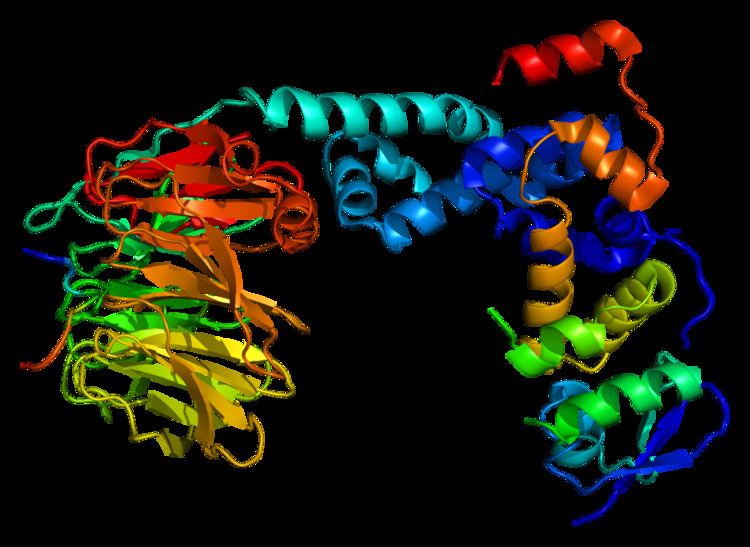Entrez 8945 | Ensembl ENSG00000166167 | |
 | ||
Aliases BTRC, BETA-TRCP, FBW1A, FBXW1, FBXW1A, FWD1, bTrCP, bTrCP1, betaTrCP, beta-transducin repeat containing E3 ubiquitin protein ligase External IDs MGI: 1338871 HomoloGene: 39330 GeneCards: BTRC | ||
F-box/WD repeat-containing protein 1A (FBXW1A) also known as βTrCP1 or Fbxw1 or hsSlimb or pIkappaBalpha-E3 receptor subunit is a protein that in humans is encoded by the BTRC (beta-transducin repeat containing) gene.
Contents
This gene encodes a member of the F-box protein family which is characterized by an approximately 40 residue structural motif, the F-box. The F-box proteins constitute one of the four subunits of ubiquitin protein ligase complex called SCFs (Skp1-Cul1-F-box protein), which often, but not always, recognize substrates in a phosphorylation-dependent manner. F-box proteins are divided into 3 classes:
The protein encoded by this gene belongs to the Fbxw class as, in addition to an F-box, this protein contains multiple WD40 repeats. This protein is homologous to Xenopus βTrCP, yeast Met30, Neurospora Scon2 and Drosophila Slimb. In mammals, in addition to βTrCP1, a paralog protein (called βTrCP2 or FBXW11) also exists, but, so far, their functions appear redundant and indistinguishable.
Discovery
Human βTrCP (referred to both βTrCP1 and βTrCP2) was originally identified as a cellular ubiquitin ligase that is bound by the HIV-1 Vpu viral protein to eliminate cellular CD4 by connecting it to the proteolytic machinery. Subsequently, βTrCP was shown to regulate multiple cellular processes by mediating the degradation of various targets. Cell cycle regulators constitute a major group of βTrCP substrates. During S phase, βTrCP keeps CDK1 in check by promoting the degradation of the phosphatase CDC25A, whereas in G2, βTrCP contributes to CDK1 activation by targeting the kinase WEE1 for degradation. In early mitosis, βTrCP mediates the degradation of EMI1, an inhibitor of the APC/C ubiquitin ligase complex, which is responsible for the anaphase-metaphase transition (by inducing the proteolysis of Securin) and mitotic exit (by driving the degradation of mitotic CDK1 activating cyclin subunits). Furthermore, βTrCP controls APC/C by targeting REST, thereby removing its transcriptional repression on MAD2, an essential component of the spindle assembly checkpoint that keeps APC/C inactive until all chromatids are attached to the spindle microtubles.
Function
βTrCP plays important roles in regulating cell cycle checkpoints. In response to genotoxic stress, it contributes to turn off CDK1 activity by mediating the degradation of CDC25A in collaboration with Chk1, thereby preventing cell cycle progression before the completion of DNA repair. During recovery from DNA replication and DNA damage, βTrCP instead targets Claspin in a Plk1-dependent manner.
βTrCP has also emerged as an important player in protein translation, cell grow and survival. In response to mitogens, PDCD4, an inhibitor of the translation initiation factor eIF4A, is rapidly degraded in a βTrCP- and S6K1-dependent manner, allowing efficient protein translation and cell growth. βTrCP also cooperates with mTOR and CK1α to induce the degradation of DEPTOR (an mTOR inhibitor), thereby generating an auto-amplification loop to promote the full activation of mTOR. At the same time, βTrCP mediates the degradation of the pro-apoptotic protein BimEL to promote cell survival.
βTrCP also associates with phosphorylated IkappaBalpha and beta-catenin destruction motifs, probably functioning in multiple transcriptional programs by regulating the NF-kappaB and the WNT pathways.
Interactions
BTRC (gene) has been shown to interact with:
Clinical Significance
βTrCP behaves as an oncoprotein in some tissues. Elevated levels of βTrCP expression have been found in colorectal, pancreatic, hapatoblastoma, and breast cancers.
